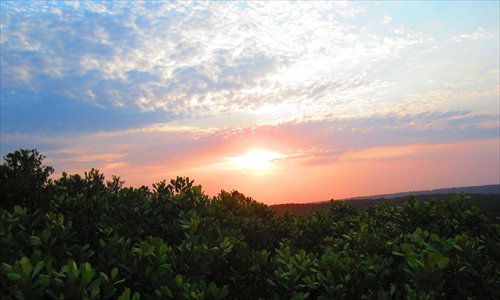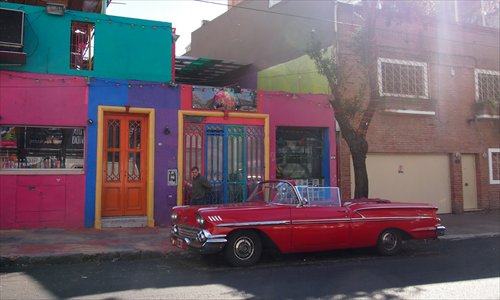Ready for romance
Exotic destinations for lovers

The sunset at Dovela Photo: Gaia Manco

The trendy neighborhood of Palermo Viejo, perfect for shopping, eating out and drinking Photo: Gaia Manco
Are you planning your honeymoon or a special anniversary? Organizing the perfect romantic trip depends on your definition of romance. Fun? Adventure? Relaxation? Luxury? And more importantly: what does your partner value the most?
Here are two unusual proposals from the Southern Hemisphere on where to kick off your honeymoon that for sure won't make you regret you said "I do."
The two destinations, one in South America, one in Africa, are both unusual starting points for the holiday of a lifetime. Which one will you choose?
Buenos Aires
For lovers of tango and movida
Can you imagine a sexier dance than tango? Although a holiday might not be enough to become a tanguero, you can enjoy the atmosphere of Buenos Aires' lively nightlife and trendy lifestyle.
Moreover, the current exchange rate of the Argentinian peso makes a holiday in Argentina affordable for most foreign travellers.
The capital of Argentina is a city where beauty triumphs and the Portenos (as the residents of Buenos Aires are called) are crazy about fashion, so it is a wonderful place to start your holiday in style.
During the day, you can explore the architecture and the history of this multilayered city, where each neighborhood has a different personality.
The old neighborhood of San Telmo is ideal for a morning stroll through the antique shops and the picturesque European style buildings. You are never too far away from a café offering all kinds of delicious facturas ("pastries" often filled with custard or dulche de leche), to enjoy sitting in the sun in a cobblestone terrace.
The iconic Plaza de Mayo and the Casa Rosada (the Pink house, the presidential palace) constitute the heart of the city center, where you can admire the French style buildings of the times - from the 19th century till the 1940s - when Argentina was an economic power and the dream land for many poor European migrants.
Another must see is the Cemeterio de la Recoleta, in the posh neighborhood of Recoleta: the cemetery is literally a city of the dead, with impressive building-like tombs detailing the story of its - extremely wealthy and powerful - occupants. The cemetery is indeed Buenos Aires' number one touristy destination, and owes most of its international popularity from being the resting place of beloved national hero Evita Peron, who was immortalized in the 1996 Alan Parker movie.
A capital of culture, Buenos Aires is a city where theaters and museums abound. I would recommend checking out the Museo de Arte Latinoamericano de Buenos Aires (MALBA) and enjoy an encompassing collection of the works of Latin America's most revered artists from the 20th and the 21st century. The museum also has a stylish cafe and a cinema for art-house movies.
On top of being the home of literary geniuses such as Jorge Luis Borges and Julio Cortazar, Argentina has an interesting and very well developed tradition of comic strip writing (think of the world-famous character Mafalda) as a visit to the Museo del Humor (Humor Museum) will confirm. The museum is located in the modern neighborhood of Buenos Aires, Puerto Madero, where high rise glass buildings overlook the Rio de la Plata, Buenos Aires' river (literally, the "silver river").
By night, your choice of entertainment is endless. The trendy neighborhood of Palermo should be your first choice for pre-dinner drinks, dinner and after dinner cocktails.
Argentinian cuisine benefits from the influence of its many migrant communities (Italian, Spanish, Portuguese) as well as from the tastes from neighboring countries. Be sure to try the famous asado (barbecue), made from Argentinian precious beef cuts such as lomo (fillet steak).
If you want to enjoy or maybe even dance tango, you will find milongas (dance halls for tango) all over the city, with performances taking place even on the streets and tango classes for all levels (check the courses available at the Academia Nacional del Tango).
Alternatively, you can enjoy world-class opera, classic music or ballet at the Teatro Colon, named by the National Geographic the third best opera house in the world.
Being a city so focused on beauty and appearance, Buenos Aires is also a joy for shoppers. The uber-trendy neighborhood of Palermo Viejo offers a peek into Argentinian design: elegant, sexy and colorful are often the traits of Argentinian frocks, for both men and women.
When you are tired of city life, you can do like the locals and continue your trip to the beaches of Punta del Este, in Uruguay, which is only a little hour away from Buenos Aires by plane.
The coastal town, dubbed the Monaco of South America, is the favorite holiday spot of the young, rich and famous of both Uruguay and Argentina. In terms of how important it is to look good and live well in Punta del Este, it can definitely be considered another neighborhood of Buenos Aires!
Planning your trip
When to go: Except for summer (which is ending now), when the weather can be hot and humid, the climate in Buenos Aires is pleasant throughout the year. Winters (July-August) are mild.
How to get there: It's a long way to fly to Buenos Aires from China. You'll need to take into account one full day for the trip, with stopovers in Europe and/or in the US.
Where to eat and drink: Try the tasting menu at Hernan Gipponi, probably one of the most renowned Argentinian chefs, at his own restaurant in Palermo Viejo. Frank's Bar, in the same neighborhood, offers sophisticated cocktails and the real atmosphere of a speak-easy. Be prepared: You must get the secret password from their Facebook page or you won't get in!
What to bring home: Tango shoes and Dulce de leche: a milk caramel sauce that is omnipresent in Argentinian pastries, and rightly so!
Southern Mozambique
For lovers of relaxation and luxury
If your idea of romance is a long walk on the beach holding hands with your sweetheart, then head to Mozambique.
Mozambique lays on the southern African coasts of the Indian Ocean and offers to travelers both seaside luxurious relaxation and wildlife adventure.
Fine sands, the pure water of the ocean, the shadows of the coconut trees, the chirping of wild birds, no cars (nor paved roads for what it matters) in sight... This is what you can expect from a holiday in Southern Mozambique.
Several resorts are scattered around the village of Tofo, a place that you should not miss if you like snorkeling. Tofo is home to the whale shark, the largest living species of fish. Harmless to humans, it can be observed during a unforgettable snorkeling session. You can also go on an "ocean safari" to get a closer look at the humpback whales.
The beach resorts are often hidden in the peculiar mix of luscious vegetation and sand dunes. One of the Mozambican coast's hidden jewels is in my opinion "Les Dunes de Dovela" resort. The resort brings the idea of glamping (glamor camping) to its extremes: your tents are furnished with a comfortable bed and the dinner menu will include local produce, such as giant prawns and lobsters, cooked "à la française."
Expect to observe the whales passing by while you take your breakfast off the terrace of your tent and to cross paths with monkeys on your way to the beach. Or you could watch the sun go down over the sandy dunes and then sip champagne while gazing at the ocean: that's romanticism with style.
Most resorts offer guided excursions to observe the rich flora and fauna of the region.
In order to get to the resort of your choice you'll have to pass by the city of Inhambane, and by its tiny airport.
The sleepy atmosphere of this Portuguese colonial city constitutes a charming stop. Walking through its sunny alleys you'll get a strange and pleasant feeling of getting lost: the city has a Mediterranean flair, and at the same time harbors a mix of several communities, from Mozambican, of course, to Indian and Muslim.
Once you feel relaxed enough, you can move to neighboring South Africa for some additional adventure in one of the many national parks. The most famous of all, the Kruger Park, is at the border between South Africa and Mozambique. On a guided safari in a South African park or reserve you'll be able to spot all the "big five": buffaloes, lions, elephants, leopards and rhinos. Get your camera gear ready!
Planning your trip
When to go: Being in a different hemisphere, seasons are opposite to what they are in China, but all year round the climate of Mozambique is mild. Temperatures are between 13°C and 25°C in winter (July) and between 25°C and 30°C in summer (January). Whale season is from September to December.
How to get there: In order to get to the southern coast of Mozambique you'll need to fly to South Africa first (there are direct flights from Beijing to Johannesburg International Airport) and then to Inhambane. Hotels and resorts can be scattered around the coast and difficult to access even with a 4x4. Be sure that your hotel/resort arranges a way to reach them for you.
Where to stay: For your stop in Inhambane I can recommend the Pensao Pachica, directly on the harbor. And a beach resort "Les Dunes de Dovela" in the small village of Dovela.
What to eat: Cashew nut cake and obviously seafood: crab, lobsters, prawns and octopus.
What to bring home: A Batik painting. Wooden or metal colorful figurines portraying daily life scenes, sold on street markets. Cashew nuts.